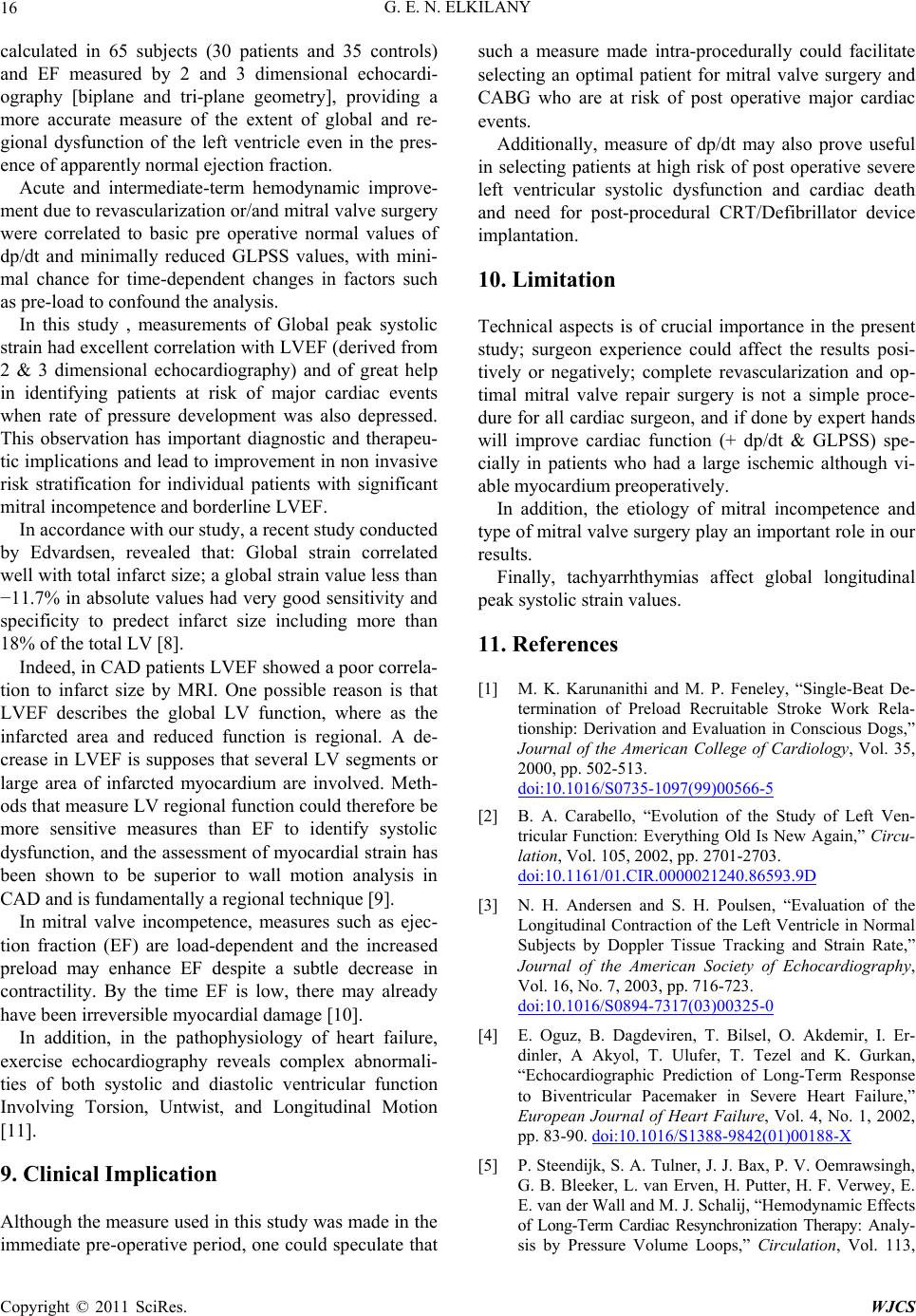
G. E. N. ELKILANY
16
calculated in 65 subjects (30 patients and 35 controls)
and EF measured by 2 and 3 dimensional echocardi-
ography [biplane and tri-plane geometry], providing a
more accurate measure of the extent of global and re-
gional dysfunction of the left ventricle even in the pres-
ence of apparently normal ejection fraction.
Acute and intermediate-term hemodynamic improve-
ment due to revascularization or/and mitral valve surgery
were correlated to basic pre operative normal values of
dp/dt and minimally reduced GLPSS values, with mini-
mal chance for time-dependent changes in factors such
as pre-load to confound the analysis.
In this study , measurements of Global peak systolic
strain had excellent correlation with LVEF (derived from
2 & 3 dimensional echocardiography) and of great help
in identifying patients at risk of major cardiac events
when rate of pressure development was also depressed.
This observation has important diagnostic and therapeu-
tic implications and lead to improvement in non invasive
risk stratification for individual patients with significant
mitral incompetence and borderline LVEF.
In accordance with our study, a recent study conducted
by Edvardsen, revealed that: Global strain correlated
well with total infarct size; a global strain value less than
−11.7% in absolute values had very good sensitivity and
specificity to predect infarct size including more than
18% of the total LV [8].
Indeed, in CAD patients LVEF showed a poor correla-
tion to infarct size by MRI. One possible reason is that
LVEF describes the global LV function, where as the
infarcted area and reduced function is regional. A de-
crease in LVEF is supposes that several LV segments or
large area of infarcted myocardium are involved. Meth-
ods that measure LV regional function could therefore be
more sensitive measures than EF to identify systolic
dysfunction, and the assessment of myocardial strain has
been shown to be superior to wall motion analysis in
CAD and is fundamentally a regional technique [9].
In mitral valve incompetence, measures such as ejec-
tion fraction (EF) are load-dependent and the increased
preload may enhance EF despite a subtle decrease in
contractility. By the time EF is low, there may already
have been irreversible myocardial damage [10].
In addition, in the pathophysiology of heart failure,
exercise echocardiography reveals complex abnormali-
ties of both systolic and diastolic ventricular function
Involving Torsion, Untwist, and Longitudinal Motion
[11].
9. Clinical Implication
Although the measure used in this study was made in the
immediate pre-operative period, one could speculate that
such a measure made intra-procedurally could facilitate
selecting an optimal patient for mitral valve surgery and
CABG who are at risk of post operative major cardiac
events.
Additionally, measure of dp/dt may also prove useful
in selecting patients at high risk of post operative severe
left ventricular systolic dysfunction and cardiac death
and need for post-procedural CRT/Defibrillator device
implantation.
10. Limitation
Technical aspects is of crucial importance in the present
study; surgeon experience could affect the results posi-
tively or negatively; complete revascularization and op-
timal mitral valve repair surgery is not a simple proce-
dure for all cardiac surgeon, and if done by expert hands
will improve cardiac function (+ dp/dt & GLPSS) spe-
cially in patients who had a large ischemic although vi-
able myocardium preoperatively.
In addition, the etiology of mitral incompetence and
type of mitral valve surgery play an important role in our
results.
Finally, tachyarrhthymias affect global longitudinal
peak systolic strain values.
11. References
[1] M. K. Karunanithi and M. P. Feneley, “Single-Beat De-
termination of Preload Recruitable Stroke Work Rela-
tionship: Derivation and Evaluation in Conscious Dogs,”
Journal of the American College of Cardiology, Vol. 35,
2000, pp. 502-513.
doi:10.1016/S0735-1097(99)00566-5
[2] B. A. Carabello, “Evolution of the Study of Left Ven-
tricular Function: Everything Old Is New Again,” Circu-
lation, Vol. 105, 2002, pp. 2701-2703.
doi:10.1161/01.CIR.0000021240.86593.9D
[3] N. H. Andersen and S. H. Poulsen, “Evaluation of the
Longitudinal Contraction of the Left Ventricle in Normal
Subjects by Doppler Tissue Tracking and Strain Rate,”
Journal of the American Society of Echocardiography,
Vol. 16, No. 7, 2003, pp. 716-723.
doi:10.1016/S0894-7317(03)00325-0
[4] E. Oguz, B. Dagdeviren, T. Bilsel, O. Akdemir, I. Er-
dinler, A Akyol, T. Ulufer, T. Tezel and K. Gurkan,
“Echocardiographic Prediction of Long-Term Response
to Biventricular Pacemaker in Severe Heart Failure,”
European Journal of Heart Failure, Vol. 4, No. 1, 2002,
pp. 83-90. doi:10.1016/S1388-9842(01)00188-X
[5] P. Steendijk, S. A. Tulner, J. J. Bax, P. V. Oemrawsingh,
G. B. Bleeker, L. van Erven, H. Putter, H. F. Verwey, E.
E. van der Wall and M. J. Schalij, “Hemodynamic Effects
of Long-Term Cardiac Resynchronization Therapy: Analy-
sis by Pressure Volume Loops,” Circulation, Vol. 113,
Copyright © 2011 SciRes. WJCS